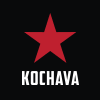Hashstash Studios is an independent game development studio from India working to develop and bring innovative and entertaining games that will hopefully tickle you to death. Their new game Circulets is an easy-to-learn family game designed for interactions between the players and includes a lot of playfulness. Kinshuk Sunil, the lead at Hashstash Studios, tells the story of creating Circulets.
My name is Kinshuk Sunil and in April 2011, I started an independent game development company with two friends of mine – Yadu Rajiv and Mayank Saini. We spent the next year working on an Android game, Zap the Knight, which is out there as an unfinished game on the Play Store and would perhaps be best described as a vaporware for now.

As the calendar turned to 2013, our priorities had shifted from making games to just plain survival. Around that time, Yadu jumped into Global Game Jam 2013 with a few friends and ended up making ‘less than three’, a local synchronous multiplayer for the PC. ‘less than three’ (a play on the heart emoticon <3) was an experiment on a concept we have been planning to work on for some time and was received very well by friends at the Jam.

One Game A Month? Can We Do It?
During the Jam, we all started talking about taking part in One Game a Month experiment. less than three became our 1GAM entry for January, and the XP boost was relieving. We internally joked and poked fun on each other about our XPs. This led to us starting to discuss what our project should be for February.
It was evident that we needed it to be very simple, because we actually wanted to finish it in February. So before anything, we decided that the release date would be February 28. Vidhvat Madan, Yadu and Vasu Chaturvedi then actively started exploring ideas about what that simple game should be. The breakthrough came on February 3rd, when Vidhvat came up with a simple prototype of collecting circles.

The idea was simple: a circle pops up on the screen and two players fight to collect it. The one who gets it, gets a point and the cycle repeats.
Wait, What Are We Making?
It was an interesting prototype, but not a game yet. Vasu, Yadu and Vidhvat were hard-pressed to find a game here. Yadu went ahead with experimenting with the idea of multiple circles instead of just one. But that made it a little confusing. There was no conflict anymore, each player could collect their circle at their leisure.

That was about the time when we set our first design objective: “It’s not about winning, it’s about who you play with”. And so we defined two factions. Each player was now assigned a color and they had to collect only their own droplets. That was what the game was called then, “Droplets”. Along with the two sides, we introduced a bonus color that was the bone of contention between the two players. With the addition of a timer and limited time, the game instantly became a riot.
Building a Game…
Around the same time, I finally jumped on board the team, primarily to take care of sounds. We were now four - Me (Kinshuk), Yadu, Vidhvat and Vasu. Between Yadu and Vidhvat, all game programming was taken care of and a huge chunk of design. Vasu added on top of it with more design. I brought sound and production to the table.
The game did not undergo any major changes since then. The base premise persisted. We did explore a different arc with a radical UI-redesign and a possible scenario where there were many more types of circulets and different behaviors in an effort to bring some tactical gameplay to the game. By this time the game had changed its name from “Droplets” to “Circulets” and that was going to stick.
…is not easy
By this time, we were fairly done with the game and started showing it to friends. The responses we started getting were amazing. A lot of them requested us to consider this as a game and treat it accordingly, and not just as a 1GAM project. Finding sense in the argument, we formally brought in the game to Hashstash and announced it to the world on February 24, 2013. At the same time, we opened up a beta with about 25 people testing out the iOS version and about a 100 for Android, we submitted the game to 100% Indie program by Samsung & Chillingo and they graciously accepted us, and Casual Connect Asia selected us for the Indie Prize Showcase at Singapore.
And then we realized a major problem in the game. While we were developers and understood what was happening inside the game, the beta players did not. What we observed was that most were not partaking in the conflict and only concentrating on their own colors. Even the bonus colors were being ignored. So began our crusade to bring a little chaos in the game world.
Over the beta, we explored different solutions but what did the trick for us were some subtle changes in visual and audio feedback within the game. Some of these were:
- while the circles popped up in their own sides, we made them slowly move towards the other side, unless they were moved by one of the players
- by throwing their circles in the other player’s side, players could now make the other player lose points
- we experimented with many audio cues for positive, negative, bonus score contributions and the current 8-bit sounds had the best influence on players
- the soundtrack samples were structured such that the pacing increases every 30s and becomes more frantic (the gameplay is structured in tiers of 30s)
To Infinity and Beyond
We also introduced a new “Infinite” mode in the game, which reverses the complete time mechanic. While the game was originally about collecting as many circles as possible in limited time, the Infinite mode lets you collect a limited number of circles in infinite time. What this does is give players an open sandbox to explore with another player. However, it is not much incentivized yet.
The whole minimalism of the game has proven to be a double-edged sword. While it brings a level of hypnotic beauty to the game and the simplicity makes it very intuitive for players; at times, it also leaves our players bewildered and confused. The limited beta was not a good enough sample for us to do anything about it quantitatively, but we are looking forward to real players and their behavior to bring in more gameplay to Circulets. Some of the concepts high on our priority list is exploration, interactivity and engagement between players.
That Hazy Glow…
All development come to a close on April 6th and we finally submitted for certification on the App Store, Samsung App Store and the Amazon App Store. We were certified and ready for sale on all our marketplaces by the 18th of April and the PR process kicked in.
Next came our trailer, the objective of which was to focus more on the interactions of people through the game, and not show the game itself. The end result proved to be pretty interesting.
Now as we try and take a breather from all the action, the chaos of first launch is on us. And it is a fun ride in itself. Circulets finally came out on May 9, 2013 on the Apple App Store, Google Play Store, Amazon App Store and the Samsung App Store.
Hashstash Studios is actively working on getting Circulets out to the world, as well as started work on their next project titled Vertigo, which will also be showcased at Casual Connect Asia 2013 along with Circulets. Connect with them on Facebook and Twitter.
Comments












